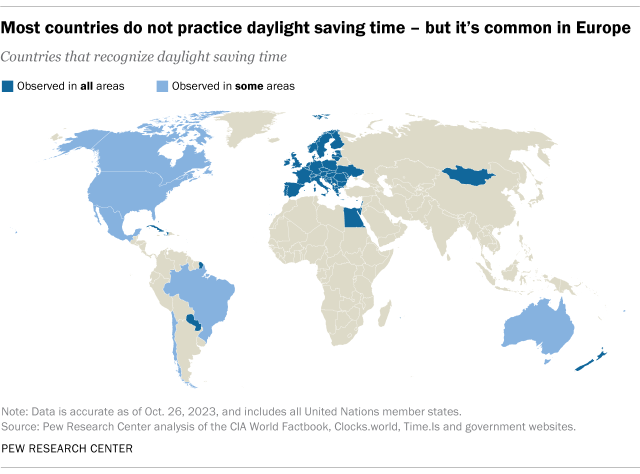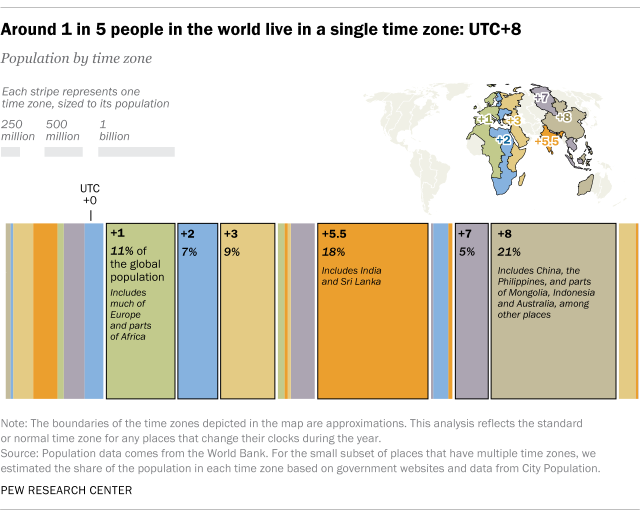Most Europeans will adjust their clocks on Oct. 29 to “fall back” an hour, and most Americans will do the same on Nov. 5. But Europe and the United States are more the exception than the rule. Most countries do not observe daylight saving time – the practice of advancing and winding back clocks seasonally in the spring and fall.
With most Europeans and Americans getting ready to “fall back” an hour, Pew Research Center conducted this analysis to find out which countries observe daylight saving time (or otherwise change their clocks on a regular basis, even if they don’t call it daylight saving time). We also examined the time zone(s) that each country uses.
The bulk of this analysis focuses on the 193 countries that are United Nations member states. We also relied on the UN for any discussion of regional groupings but used the World Bank’s definition of North America, which includes Canada and the U.S.
Information about daylight saving time and time zones comes primarily from cross-referencing three websites: the CIA World Factbook, Clocks.world and Time.is. We also examined various news sources and government websites to confirm these findings.
To calculate the percentage of the world’s population in each time zone, we relied on population statistics compiled by the World Bank. For the small subset of places that have more than one time zone, we estimated the share of the population in each time zone based on government websites and data from City Population.
For countries that follow daylight saving time or otherwise switch their clocks each year, the population analysis uses their standard or normal, non-daylight-saving time zone(s).
Here are seven facts about daylight saving time and time zones around the world:
Only about a third of the world’s countries practice daylight saving time, and the vast majority of them are in Europe. Within Europe – as defined by the United Nations – only Armenia, Azerbaijan, Belarus, Georgia, Iceland, Russia and Turkey do not practice daylight saving time.
Outside of Europe, daylight saving time is most common in North America – where parts of the U.S. and Canada use it – as well as Latin America and the Caribbean.
Egypt stands out as the only African nation with daylight saving time.

About half of all countries in the world observed daylight saving time in the past but no longer do so. In the last decade alone, Azerbaijan, Iran, Jordan, Namibia, Russia, Samoa, Syria, Turkey and Uruguay have all ended their seasonal time changes. In 2022, the Mexican congress also voted to abolish summer time in most of the country, though large Mexican cities near the U.S. border and a few other places are exempted.
Egypt has the unique distinction of having ended daylight saving within the last decade (2014) and bringing it back. This year, the country again adjusted its clocks in an effort to save energy.
While most of Europe and the U.S. practice daylight saving time, some policymakers in the European Commission and in the U.S. Congress have proposed doing away with it.
Some countries, including the U.S., have daylight saving time in only part of the country. In the U.S., Hawaii and most of Arizona, as well as some territories, do not observe daylight saving time. Australia, Brazil and Canada are similar. For example, in Australia, daylight saving is not observed in Queensland, the Northern Territory, Western Australia, Christmas Island or the Cocos (Keeling) Islands.
Some countries have changed their time zones in the past decade for political or economic reasons. For example, President Nicolás Maduro in Venezuela decided in 2016 to reverse his predecessor’s time zone change – which was intended to allow children to wake up for school in the daylight – because of concerns about electricity consumption.
In 2018, North Korean leader Kim Jong Un changed his country’s clocks to match those of South Korea in advance of a historic summit – reversing his 2015 decision to establish his own time zone, Pyongyang time.
São Tomé and Príncipe changed its time zone twice – once in 2018 as part of a strategic development plan and again in 2019 under a new prime minister, restoring the previous time zone.
Since 2018, Morocco has also permanently been on daylight saving time (essentially switching its time zone from UTC+0 to UTC+1), changing its clocks based on Ramadan rather than for summer and winter time.
The U.S. is one of the few countries with multiple time zones. Only around 20 countries in the world have more than one time zone – often because they administer overseas territories.
France, for example, is often cited as the country with the most time zones – 12 or 13, depending on the time of year. But everyone living in metropolitan France – the part of France located in Europe – resides within a single time zone.
Russia has the most contiguous time zones, with 11.
The U.S., for its part, has nine time zones, with six of them covering the 50 states and the remaining three applying to territories. And some U.S. states even have more than one time zone within them.
The vast majority of countries are “on the hour,” but a few are not. In most of the world, entering a new time zone means you only need to adjust the hour hand on your watch. But visiting a few countries requires you to adjust the minute hand, too.
Afghanistan (UTC+4.5), India (UTC+5.5), Iran (UTC+3.5), Myanmar (UTC+6.5) and Sri Lanka (UTC+5.5) are all on the half hour, while Nepal (UTC+5.75) is on the 45-minute mark relative to most other time zones. (UTC is Universal Time Coordinated or Coordinated Universal Time and was called Greenwich Mean Time, or GMT, prior to 1972.)
Also, Australia and Canada each have some places that are on the hour and some that are on the half hour. In New Zealand, most of the country is on the hour, but the Chatham Islands are on the 45-minute mark.
If you want to schedule a meeting that’s convenient for the most people on Earth, consider using the UTC+8 time zone. Around a fifth of the world’s population lives in this time zone, which includes all of China. UTC+8 also includes all or part of other populous countries such as the Philippines, Indonesia and Australia, among other places.
Another good option for your meeting would be UTC+5.5, the time zone that includes India – the world’s most populous nation – along with Sri Lanka. This time zone is home to about 18% of the world’s population.


